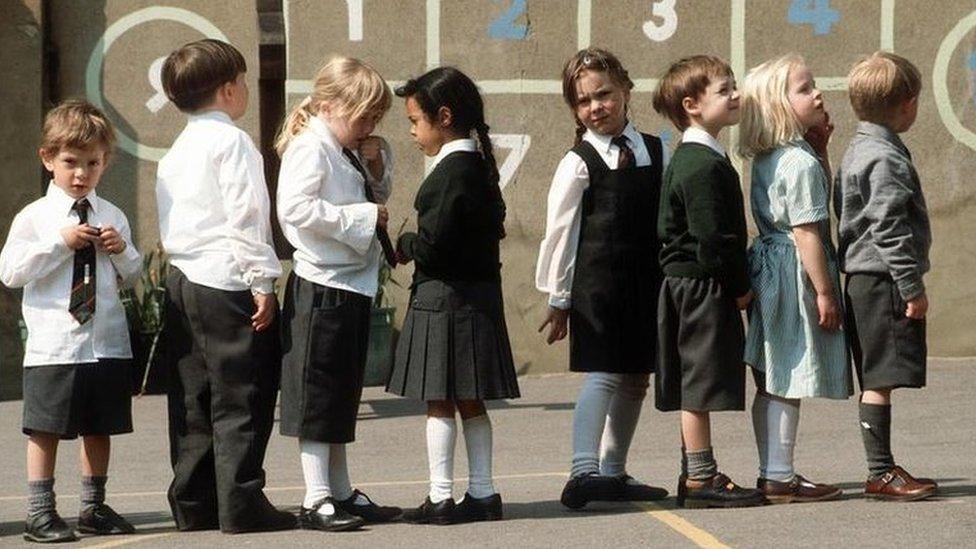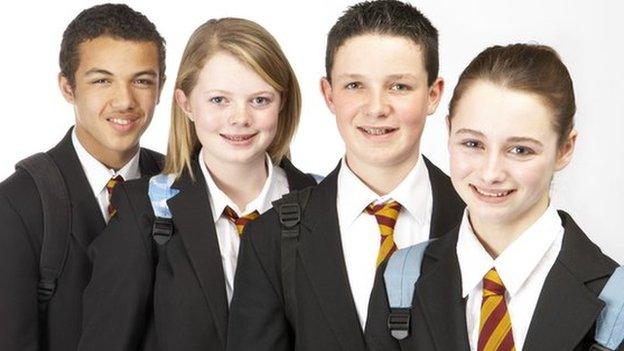School uniform prices raised by supplier contracts, says CMA
- Published

The cost of school uniforms has risen by up to £10 an item owing to the use of exclusive suppliers, according to the UK's competition authority.
School governors must ensure that deals allow parents to get good value for money, the Competition and Markets Authority (CMA) has said.
Complaints from parents have prompted the CMA to write an open letter to governors and suppliers in England.
It has the power to fine suppliers if they are found to be anti-competitive.
The CMA said there was no intention to take any legal action at this stage, but it has joined forces with various associations to call on schools and suppliers to review their agreements.
The Schoolwear Association, which represents suppliers, said that exclusive deals often ensured that uniforms of good quality were available in all sizes.
Shopping around

School uniforms have changed since the days of Grange Hill
The authority said that exclusive deals could mean parents were not getting value for money, with "strong evidence" that they had increased prices.
"Buying school uniforms can be very expensive and particularly hits low-income families and those with a number of children, so it is important parents and carers are able to shop around," said Ann Pope, senior director at the CMA.
"We will continue monitoring the sector and will consider taking enforcement action, if it is necessary."
The move follows a review of school uniform costs in 2012 which found:
Three-quarters of state schools placed restrictions on where uniforms could be bought
Restrictions led to parents of primary school children paying £4.9m more than they need to, and parents of secondary school pupils paying £5.5m more
Quality and consistency were the primary reasons for the exclusive deals being put in place
The Children's Society said that many parents were being prevented from buying cheaper school clothing from supermarkets.
"School uniform costs can be a millstone around the necks of poorer parents, contributing to a cycle of debt and damaging the opportunities and well-being of lower income pupils," said Sam Royston, director of policy at the society.
The National Governors' Association said schools should do all they could to keep costs to a minimum.
Guidance for schools in England set by the Department for Education says that schools and governing bodies should ensure parents are getting good value for money.
The Schoolwear Association said it was keen to work with the CMA.
"There are some benefits to sole supplier arrangements, particularly because a single supplier is dedicated to the school and required to stock uniform all year round in all sizes," said the association's chairman, David Burgess.
"When there are two or more suppliers, that sense of duty diminishes, and the school has less power to demand best value and service levels. If a school decides on a sole supplier arrangement, we strongly recommend periodically putting contracts out to tender where quotations can be compared on quality, service levels, year-round stocking, ethical sourcing and price."
He added that suppliers were often local and independent and that they considered quality and sustainability.
"We are anxious that the focus on school uniform should not be solely on price at the expense of poorer quality. We should remember that children spend an average of 10 hours a day in their uniform, so comfort and durability are vital," he said.
The association has called on the government to remove VAT from school uniforms and introduce a voucher scheme, similar to childcare vouchers, to assist parents with the cost.
- Published5 September 2014

- Published12 August 2015
